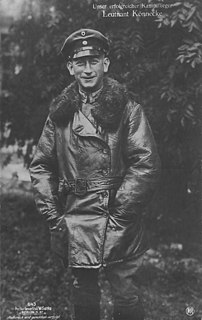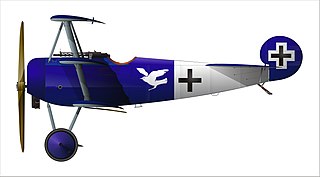Related Research Articles

Julius Buckler was a German First World War fighter ace credited with 36 victories during the war. He shot down 29 enemy airplanes and 7 balloons; two other Victories went unconfirmed. He was one of only four German fighter aces to win Germany's highest decorations for valor for both enlisted man and officer.

Otto Kissenberth was a German flying ace of World War I credited with 20 aerial victories. He was a prewar mechanical engineer who joined the German air service in 1914. After being trained and after serving as a reconnaissance pilot, he became one of the first German fighter pilots, flying with Kampfeinsitzerkommando KEK Einsisheim. He scored six victories with this unit as it morphed into a fighter squadron, Jagdstaffel 16. His success brought him command of Jagdstaffel 23 on 4 August 1917. He would run his victory tally to 20, downing his final victim using a captured British Sopwith Camel on 20 May 1918. Nine days later, a crash while flying the Camel ended Kissenberth's combat career. His injuries were severe enough he was not returned to combat, instead being assigned to command Schleissheim's flying school. Although Otto Kissenberth survived the war, he died soon after in a mountaineering accident on 2 August 1919.

LeutnantOtto Könnecke PLM, MMC, HoH, IC, was a leading German ace of World War I with 35 victories. He was one of only five pilots to receive Germany's highest decorations for both enlisted pilot and officer. He later became one of the founding pilots of Deutsche Luft Hansa and assisted in development of the new Luftwaffe.

Major Josef Mai Iron Cross First and Second Class, was a World War I fighter pilot credited with 30 victories.
Generalmajor Hermann Frommherz Military Order of St. Henry, Royal House Order of Hohenzollern, Knight's Cross of the Military Karl-Friedrich Merit Order, began his military career in World War I as a German ace fighter pilot. He was credited with 32 victories. During World War II he was involved in the German takeover of Czechoslovakia and rose to become a Luftwaffe Generalmajor.

Adolf, Ritter von Tutschek Pour le Mérite, Royal House Order of Hohenzollern, Iron Cross, Military Order of Max Joseph, was a professional soldier turned aviator who became a leading fighter ace with 27 victories. As German air strategy turned towards concentrated air power, he was entrusted with one of the world's first fighter wings.
Oberleutnant Friedrich Ritter von Röth was a German World War I fighter ace with 28 victories. He was the most successful German pilot at the extremely hazardous practice of shooting down enemy observation balloons, and destroyed 20 of them. Röth concentrated on observation balloons because they were large enough targets for him to see and hit with machine gun fire.
Generalmajor Otto Fruhner MMC, IC, was a German World War I flying ace credited with 27 victories. He was one of the first aviators to parachute from a stricken aircraft.
Lieutenant Karl Thom, was a German World War I flying ace credited with 27 victories. He was decorated with both his nation's highest decorations for valor, the Military Merit Cross as an enlisted soldier, and the Pour le Mérite after he was commissioned as an officer. He was one of only four German aces of World War I to achieve this double award.

Oberleutnant Eduard Ritter von Dostler, Pour le Mérite, Royal House Order of Hohenzollern, Military Order of Max Joseph, Iron Cross, was a German World War I fighter ace credited with 26 victories. On three consecutive assignments during World War I, Dostler was entrusted with leadership of German jagdstaffeln.
Leutnant Georg von Hantelmann was a German fighter ace credited with winning 25 victories during World War I. It was notable that these victories included three opposing aces shot down within the same week in September 1918–David Putnam, Maurice Boyau, and Joseph Wehner.
Leutnant Ludwig Hanstein HOH, Bavaria's MMO was a World War I flying ace credited with 16 aerial victories.
LeutnantKarl Odebrett was a German World War I flying ace credited with 16 aerial victories.
LeutnantWilhelm Anton Seitz was a German World War I flying ace credited with 16 aerial victories. He scored those victories over a two-year span, beginning on 17 November 1916 and ending on 4 November 1918.
Colonel Alois Heldmann was a World War I flying ace credited with 15 confirmed aerial victories while he was a leutnant. He later joined the nascent Luftwaffe in 1933 and was a flying school inspector through the end of World War II.
Hans-Georg von der Marwitz was a German World War I flying ace credited with 15 aerial victories.
Leutnant Hans von Keudell was a World War I flying ace credited with twelve aerial victories.

Royal Prussian Jagdstaffel 15, commonly abbreviated to Jasta 15, was a "hunting group" of the Luftstreitkräfte, the air arm of the Imperial German Army during World War I. The unit would score over 150 aerial victories during the war, at the expense of seven killed in action, two killed in flying accidents, three wounded in action, one injured in a flying accident, and two taken prisoner of war.
OffizierstellvertreterRobert Heibert MMC IC was a German flying ace during World War I. He was credited with 13 confirmed aerial victories; he also had seven unconfirmed claims.
Leutnant Adolf Schulte IC was a German World War I flying ace credited with nine aerial victories. His short gallant career would end in a fatal midair crash with his enemies.
References
- Franks, Norman; Bailey, Frank W.; Guest, Russell. Above the Lines: The Aces and Fighter Units of the German Air Service, Naval Air Service and Flanders Marine Corps, 1914–1918. Grub Street, 1993. ISBN 0-948817-73-9, ISBN 978-0-948817-73-1.
- Franks, Norman. Albatros Aces of World War 1. Part 1 of Albatros Aces of World War I. Osprey Publishing, 2000. ISBN 1-85532-960-3, ISBN 978-1-85532-960-7.
- Norman Franks, Greg VanWyngarden. Fokker Dr I Aces of World War I. Osprey Publishing, 2001. ISBN 1-84176-223-7, ISBN 978-1-84176-223-4.